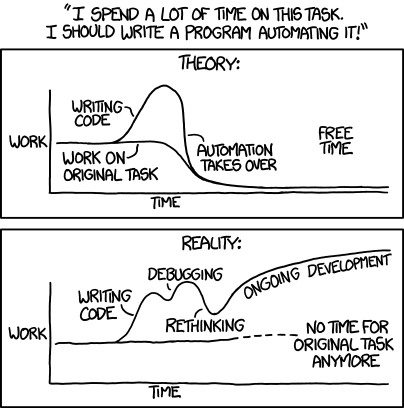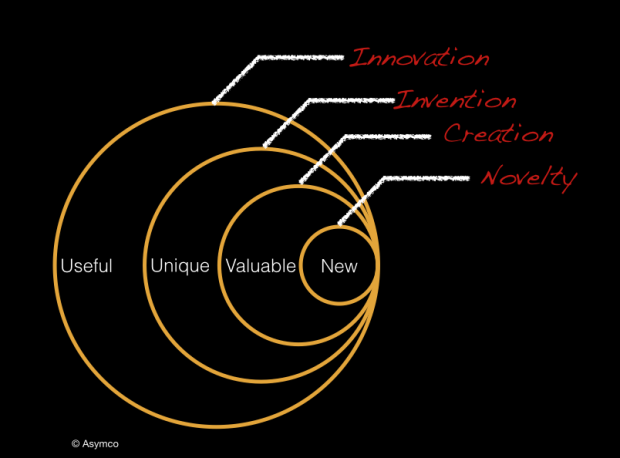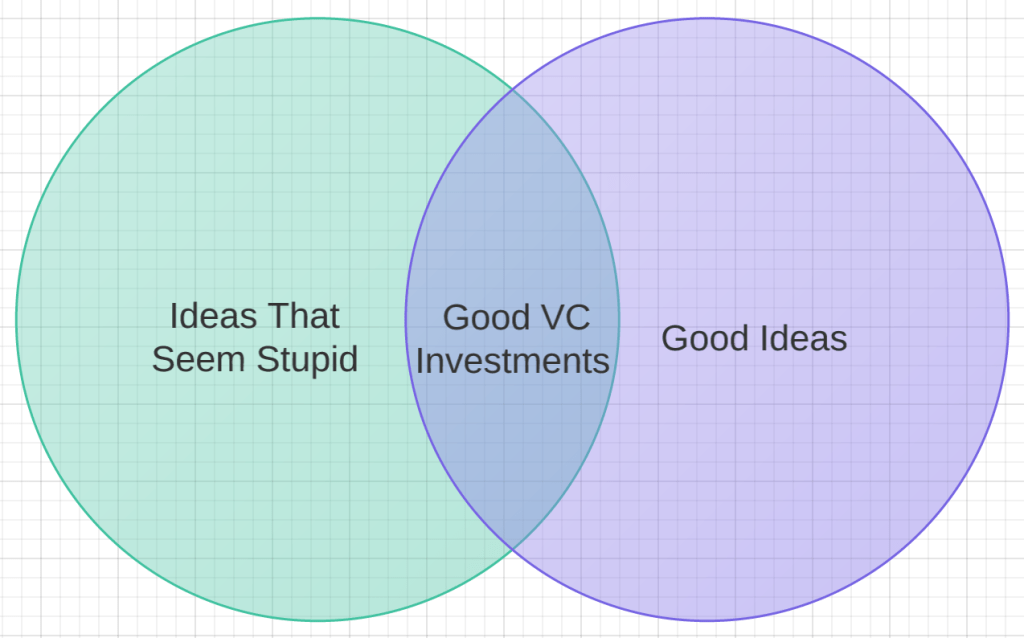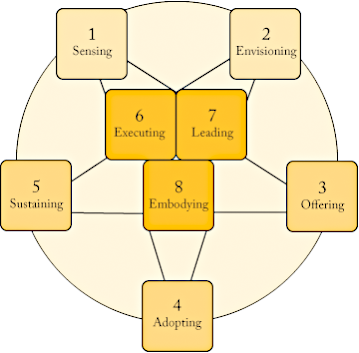Innovation is about finding a better way of doing something. Like many of the new development buzzwords (which many of them are over-used on many business documents), the concept of innovation originates from the world of business. It refers to the generation of new products through the process of creative entrepreneurship, putting it into production, and diffusing it more widely through increased sales. Innovation can be viewed as t he application of better solutions that meet new requirements, in-articulated needs, or existing market needs. This is accomplished through more effective products, processes, services, technologies, or ideas that are readily available to markets, governments and society. The term innovation can be defined as something original and, as a consequence, new, that “breaks into” the market or society.
Innoveracy: Misunderstanding Innovation article points out that there is a form of ignorance which seems to be universal: the inability to understand the concept and role of innovation. The way this is exhibited is in the misuse of the term and the inability to discern the difference between novelty, creation, invention and innovation. The result is a failure to understand the causes of success and failure in business and hence the conditions that lead to economic growth. The definition of innovation is easy to find but it seems to be hard to understand. Here is a simple taxonomy of related activities that put innovation in context:
- Novelty: Something new
- Creation: Something new and valuable
- Invention: Something new, having potential value through utility
- Innovation: Something new and uniquely useful
The taxonomy is illustrated with the following diagram.
The differences are also evident in the mechanisms that exist to protect the works: Novelties are usually not protectable, Creations are protected by copyright or trademark, Inventions can be protected for a limited time through patents (or kept secret) and Innovations can be protected through market competition but are not defensible through legal means.
Innovation is a lot of talked about nowdays as essential to businesses to do. Is innovation essential for development work? article tells that innovation has become central to the way development organisations go about their work. In November 2011, Bill Gates told the G20 that innovation was the key to development. Donors increasingly stress innovation as a key condition for funding, and many civil society organisations emphasise that innovation is central to the work they do.
Some innovation ideas are pretty simple, and some are much more complicated and even sound crazy when heard first. The is place for crazy sounding ideas: venture capitalists are gravely concerned that the tech startups they’re investing in just aren’t crazy enough:
Not all development problems require new solutions, sometimes you just need to use old things in a slightly new way. Development innovations may involve devising technology (such as a nanotech water treatment kit), creating a new approach (such as microfinance), finding a better way of delivering public services (such as one-stop egovernment service centres), identifying ways of working with communities (such as participation), or generating a management technique (such as organisation learning).
Theorists of innovation identify innovation itself as a brief moment of creativity, to be followed by the main routine work of producing and selling the innovation. When it comes to development, things are more complicated. Innovation needs to be viewed as tool, not master. Innovation is a process, not a one time event. Genuine innovation is valuable but rare.
There are many views on the innovation and innvation process. I try to collect together there some views I have found on-line. Hopefully they help you more than confuze. Managing complexity and reducing risk article has this drawing which I think pretty well describes innovation as done in product development:
8 essential practices of successful innovation from The Innovator’s Way shows essential practices in innovation process. Those practices are all integrated into a non-sequential, coherent whole and style in the person of the innovator.
In the IT work there is lots of work where a little thinking can be a source of innovation. Automating IT processes can be a huge time saver or it can fail depending on situation. XKCD comic strip Automation as illustrates this:

System integration is a critical element in project design article has an interesting project cost influence graphic. The recommendation is to involve a system integrator early in project design to help ensure high-quality projects that satisfy project requirements. Of course this article tries to market system integration services, but has also valid points to consider.
Core Contributor Loop (CTTDC) from Art Journal blog posting Blog Is The New Black tries to link inventing an idea to theory of entrepreneurship. It is essential to tune the engine by making improvements in product, marketing, code, design and operations.






5,279 Comments
Tomi Engdahl says:
Ohjelmointitehtävä tulee osaksi PISA-koetta vuonna 2025
https://kodarit.com/fi/ohjelmointitehtava-tulee-osaksi-pisa-koetta-vuonna-2025/
Tomi Engdahl says:
Physicists Discover Brand-New Isotopes of Heavy Rare-Earth Elements
https://www.sciencealert.com/physicists-discover-brand-new-isotopes-of-heavy-rare-earth-elements
Never-before-seen ratios of particles making up atomic nuclei have emerged in a landmark experiment involving the fragmentation of heavy elements.
By breaking apart the nuclei of platinum, physicists led by Oleg Tarasov of Michigan State University have discovered new isotopes of rare-Earth elements thulium, ytterbium, and lutetium. It’s an achievement that scientists believe will help them understand the properties of neutron-rich nuclei and the processes that forge new elements in the collision of neutron stars.
Tomi Engdahl says:
https://hackaday.com/2024/02/18/canned-air-is-unexpectedly-supersonic/
Tomi Engdahl says:
Analog Computers May Work Better Using Spin Than Light Spin waves offer a new approach to digital computing’s counterpart
https://spectrum.ieee.org/analog-computer-spin-wave
In collaborative research out of Japan and Switzerland, scientists have taken an important step towards a next generation of analog computers by creating new types of logic gates based on spin waves. Spin waves are the waves generated when all the electrons in a system shift the alignment of their spins in one direction and at the same time.
“Both practically and in terms of research, there’s a higher potential to achieve analog computing more affordably using spin-wave technology compared to other wave-based approaches.”
Tomi Engdahl says:
US researchers develop ‘unhackable’ computer chip that works on light
Computations can be performed at light speed in this chip which is ready for deployment for building AI models immediately.
https://interestingengineering.com/innovation/unhackable-computer-chip-works-on-light
Tomi Engdahl says:
Researchers show classical computers can keep up with, and surpass, their quantum counterparts
https://phys.org/news/2024-02-classical-surpass-quantum-counterparts.html#google_vignette
Tomi Engdahl says:
ASML explores Hyper-NA chipmaking tools as the next step in shrinking transistors — tools would debut in 2030, but significant technology and cost hurdles remain
News
By Anton Shilov published 5 days ago
The world needs more shrinking, and Hyper-NA could help.
https://www.tomshardware.com/tech-industry/manufacturing/asml-explores-hyper-na-chipmaking-tools-as-the-next-step-in-shrinking-transistors-tools-would-debut-in-2030-but-significant-technology-and-cost-hurdles-remain
Tomi Engdahl says:
“I want to encourage people to solve societal challenges by thinking computationally”
Sunny Wong struggled with math classes growing up, but words of encouragement convinced him to apply to the Bachelor’s Programme in Science at the University of Helsinki. According to him, nurturing your curiosity matters more than perfect grades when it comes to computing.
https://www.helsinki.fi/en/degree-programmes/science-bachelors-programme/studying/news-archive/i-want-encourage-people-solve-societal-challenges-thinking-computationally
Tomi Engdahl says:
Separated Identical Twins Raised In The US And Korea Have Massive IQ Difference
https://www.iflscience.com/separated-identical-twins-raised-us-korea-massive-iq-difference-63596
The finding, published in the journal Personality and Individual Differences, contradicts previous studies on monozygotic twins, which have indicated an average IQ difference of no more than seven points. Commenting on the unexpectedly large gulf between the two sisters, the study authors write that “it is striking that the twins showed substantial differences in cognitive abilities that have been linked to strong genetic influence.”
Whether this discrepancy was caused by the twins’ different upbringings is hard to say, although the researchers note that the sister raised in the US had suffered three previous concussions, which may have influenced her cognitive capacities.
Tomi Engdahl says:
It’s Confirmed! Laser Fusion Experiment Hit a Critical Milestone in Power Generation
https://www.sciencealert.com/its-confirmed-laser-fusion-experiment-hit-a-critical-milestone-in-power-generation
In December 2022, scientists at the US National Ignition Facility announced a historic milestone: for the first time, their laser-powered fusion reaction had ‘broken even’, producing more energy than it consumed.
But advances as big as this need to be rigorously checked – and that can take some time.
“This achievement is the culmination of more than five decades of research and gives proof that laboratory fusion, based on fundamental physics principles, is possible,” the team members of the Indirect Drive ICF (inertial confinement fusion) Collaboration write in the first of five papers.
Tomi Engdahl says:
https://getpocket.com/explore/item/how-a-single-drop-of-olive-oil-led-to-a-great-leap-forward-in-physics
Tomi Engdahl says:
An architecture for sub-picowatt logic computing based on self-biased molybdenum disulfide transistors
https://techxplore.com/news/2024-02-architecture-picowatt-logic-based-biased.html
Tomi Engdahl says:
https://hackaday.com/2024/02/04/common-enzyme-breaks-down-pla-fast/
Tomi Engdahl says:
https://hackaday.com/2024/02/26/integration-taught-correctly/
Tomi Engdahl says:
Natriumakku hakkaa litiumakun mennen tullen
https://etn.fi/index.php/13-news/15919-natriumakku-hakkaa-litiumakun-mennen-tullen
Nykyisille akkutekniikoille etsitään koko ajan tehokkaampaa ja turvallisempaa korvaajaa. Delftin teknillisen korkeakoulun tutkijat ovat yhdessä Kiinan tiedeakatemian kanssa saattaneet löytää tähän asti parhaan akkuratkaisun.
Tutkijat ovat kehittäneet natriumioniakkuteknologiaa kehittämällä pikalatausominaisuuksia ja parantamalla negatiivista elektrodia orgaanisilla materiaaleilla, mikä vähentää riippuvuutta harvinaisista materiaaleista. Lisäksi he ovat parantaneet katodia ja luoneet korkean energiantiheyden nopeasti latautuvan materiaalin, jossa ei ole kobolttia. Tämä materiaali kestää nykyisiä pidempään, koska sen rakenne muuttuu asteittain käytön aikana.
Tomi Engdahl says:
You’ve tried plant-based meat, but here come meat-based plants
South Korean researchers infused actual rice grains with cow muscle and fat cells.
https://www.engadget.com/youve-tried-plant-based-meat-but-here-come-meat-based-plants-163654564.html
Tomi Engdahl says:
Beyond Moore’s Law: New Strategy for Developing Highly Versatile Electronics With Outstanding Performance Discovered
https://scitechdaily.com/beyond-moores-law-new-strategy-for-developing-highly-versatile-electronics-with-outstanding-performance-discovered/
Researchers at City University of Hong Kong have introduced a groundbreaking approach in semiconductor technology using mixed-dimensional transistors. This innovation paves the way for more efficient, high-performance electronics, overcoming the challenges of traditional downscaling and highlighting a significant leap towards advanced, multifunctional integrated circuits.
Tomi Engdahl says:
Researchers have developed a Very Big Disc™ that can store up to 200 terabytes of data and may represent a return to optical media for long term storage
News
By Andy Edser published February 23, 2024
You can’t keep a good disk down, it seems.
https://www.pcgamer.com/researchers-have-developed-a-very-big-disctm-that-can-store-up-to-200-terabytes-of-data-and-may-represent-a-return-to-optical-media-for-long-term-storage/
Tomi Engdahl says:
DVD’s New Cousin Can Store More Than a Petabit Containing more data than the entire Internet can transmit in a second
https://spectrum.ieee.org/data-storage-petabit-optical-disc
A novel disc the size of a DVD can hold more than 1 million gigabits—roughly as much as is transmitted per second over the entire world’s Internet—by storing data in three dimensions as opposed to two, a new study finds.
“The use of ultrahigh-density optical data storage technology in big data centers is now possible.”
—MIN GU, UNIVERSITY OF SHANGHAI FOR SCIENCE AND TECHNOLOGY
Tomi Engdahl says:
3D printed solenoids will usher in a new dawn in affordable electronics
MIT engineers achieve a breakthrough in electronics with fully 3D-printed solenoids, revolutionizing manufacturing and democratizing access to technology.
https://interestingengineering.com/innovation/mit-pioneers-3d-printed-solenoids-for-electronics
Tomi Engdahl says:
Graphene electrostatic microphone and ultrasonic radio
https://www.pnas.org/doi/10.1073/pnas.1505800112?fbclid=IwAR0HDrQquTgvt1rx2BIDOCUFXcS9jaBulVXUlArz47Ila4HCFmqkCRYYxvA
Tomi Engdahl says:
https://www.sciencealert.com/a-first-of-its-kind-signal-was-detected-in-the-human-brain
Tomi Engdahl says:
https://www.techradar.com/pro/a-single-optical-fiber-scientists-build-a-silicon-less-computer-that-use-light-waves-and-surpasses-existing-systems-for-classification-could-this-be-the-ultimate-ai-cpu
Tomi Engdahl says:
https://www.zinier.com/blog/a-brief-history-of-desks
Tomi Engdahl says:
Matemaatikko löysi jotakin niin huikeaa, että juoksi käytävälle huutamaan – Historia uusiksi: Erittäin tärkeä keksintö onkin 150 v vanhempi kuin luultiin
Desimaalipilkku ja -piste ovat vanhempi keksintö kuin tähän asti on luultu.
https://www.tekniikkatalous.fi/uutiset/matemaatikko-loysi-jotakin-niin-huikeaa-etta-juoksi-kaytavalle-huutamaan-historia-uusiksi-erittain-tarkea-keksinto-onkin-150-v-vanhempi-kuin-luultiin/ed467df8-02f9-45ea-a4b6-4d4939938764
Tomi Engdahl says:
Researchers from Australia and a private biotechnology firm in the US have successfully demonstrated the use of high-frequency radio waves to temporarily open up bacterial cell walls to introduce new genetic material into them. https://ie.social/Vpxw5
Radio waves reprogram bacteria to become vital drugs with 91% efficacy
High frequency radio waves are a far efficient method to add DNA to bacterial cells than conventional approaches such as heat shock.
https://interestingengineering.com/science/radio-waves-reprogram-bacteria-to-drugs
A collaboration between researchers at the RMIT University in Australia and a private biotechnology firm in the US has successfully demonstrated the use of high-frequency radiowaves to temporarily open up bacterial cell walls to introduce new genetic material into them.
The newly introduced material can supercharge the bacteria to produce vital medicines like insulin.
Bacteria such as E.coli are the workhorse for genetic experiments around the world. The genetic material of this simple microscopic organism can be easily modified by introducing smaller, circular bits of DNA called plasmids that carry information to carry out specific tasks.
No more ‘heat shock’
Conventionally, researchers have used the ‘heat-shock’ approach for this step, where the bacteria are shocked by exposure to a relatively high temperature in the presence of the plasmids. The shock opens the cell wall, allowing the plasmids to enter the cell.
Later, the bacteria are cooled down suddenly and expected to function normally. Over the years, this has been the industry standard for introducing plasmids. However, the approach’s effectiveness is limited since about 77 percent of the cells have a working plasmid.
The alternate approach uses gentle laser pulses to make the cell walls favorable for plasmid uptake. However, as few as 30 percent of the cells have been found to have taken up the plasmid in this approach.
Tuning up with radio waves
Previously, researchers at the Australian Centre for Electromagnetic Bioeffects Research had demonstrated the use of high-frequency electromagnetic energy to make cell walls more permeable.
The researchers used 18 GHz radio waves to open up the bacterial cells for three minutes. Following this, as many as 91 percent of the cells took on the plasmids, a significantly higher number than in the conventional heat-shock approach.
“Our novel, cost-effective method is shown to be highly efficient, but also gentler on the cells as no harsh chemicals or high temperatures are used in this process,” said Elena Ivanova, a professor at the School of Science at RMIT. “As a result, the cell survival rate was higher than other techniques.”
Interestingly, the approach can also be used in eukaryotic cells – those seen in fungi, plants, other animals, and human beings paving the way for myriad applications of this approach.
Tomi Engdahl says:
Vallankumous akkutekniikassa: vesiakku ei voi syttyä tuleen
https://etn.fi/index.php/13-news/15936-vallankumous-akkutekniikassa-vesiakku-ei-voi-syttyae-tuleen
Australialaisen RMIT-yliopiston tutkijoiden johdolla työskennellyt kansainvälinen ryhmä on kehittänyt kierrätettäviä ”vesiakkuja”, jotka eivät syty palamaan tai räjähdä. Tutkijat uskovat, että tekniikka voi lyhyellä aikavälillä korvata lyijyhappoakut ja pitkällä aikavälillä, 5–10 vuoden kuluttua, mahdollisesti litiumioniakut.
Litiumionienergian varastointi hallitsee markkinoita sen teknologisen kypsyyden vuoksi, mutta sen soveltuvuus suuren mittakaavan sähköverkon energiavarastointiin on rajallinen akkujen sisältämien epävakaisten materiaalien turvallisuusriskien vuoksi.
RMIT:n professori Tianyi Ma kertoi, että heidän vesiakkunsa ovat uuden akkuparadigman kehityksen terävimmässä kärjessä. – Mitä suunnittelemme ja valmistamme, kutsutaan vesimetalli-ioniakuiksi. Voimme kutsua niitä vesiakuiksi, sanoi Ma.
Tomi Engdahl says:
Huawei kehitti mullistavan tallennustekniikan
https://etn.fi/index.php/13-news/15950-huawei-kehitti-mullistavan-tallennustekniikan
20 prosenttia nauhajärjestelmiä edullisempi ja 90 prosenttia perinteisiä kiintolevyjä pienemi virrankulutus. Tätä lupaa Huawei uudella magneettisähköisellä tallennusmenetelmällään. OceanStor Arctic -tekniikkaa demottiin jo Barcelonan mobiilimessuilla.
Huawei mukaan uusi tallennus perustuu MED-tekniikkaan (magneto-electric disc), kuten Peter Zhou Barcelonassa esitti. Tällaisia levyjä ei vielä ole kaupallisesti tarjolla. Kyse olisi tallennusmateriaalista, joka yhdistäisi sähköisen ja magneettisen, joten levyllä olisi raitoja kuten perinteisissä kiintolevyjen medioissa.
Tomi Engdahl says:
https://hackaday.com/2024/03/06/harvard-claims-breakthrough-in-anode-behavior-of-solid-state-lithium-batteries/
Tomi Engdahl says:
https://hackaday.com/2024/03/06/the-1970s-computer-a-slice-of-computing/
Tomi Engdahl says:
Kiinteä rikkiakku askeleen lähempänä – sähköauton kantama kaksinkertaiseksi
https://etn.fi/index.php/13-news/15957-kiinteae-rikkiakku-askeleen-laehempaenae-saehkoeauton-kantama-kaksinkertaiseksi
Tomi Engdahl says:
An Optical Computer Architecture
https://hackaday.com/2024/03/12/an-optical-computer-architecture/
We always hear that future computers will use optical technology. But what will that look like for a general-purpose computer? German researchers explain it in a recent scientific paper. Although the DOC-II used optical processing, it did use some conventional electronics. The question is, how can you construct a general computer that uses only optical technology?
An All-Optical General-Purpose CPU and Optical Computer Architecture
https://arxiv.org/abs/2403.00045
Energy efficiency of electronic digital processors is primarily limited by the energy consumption of electronic communication and interconnects. The industry is almost unanimously pushing towards replacing both long-haul, as well as local chip interconnects, using optics to drastically increase efficiency. In this paper, we explore what comes after the successful migration to optical interconnects, as with this inefficiency solved, the main source of energy consumption will be electronic digital computing, memory and electro-optical conversion. Our approach attempts to address all these issues by introducing efficient all-optical digital computing and memory, which in turn eliminates the need for electro-optical conversions. Here, we demonstrate for the first time a scheme to enable general purpose digital data processing in an integrated form and present our photonic integrated circuit (PIC) implementation. For this demonstration we implemented a URISC architecture capable of running any classical piece of software all-optically and present a comprehensive architectural framework for all-optical computing to go beyond.
Tomi Engdahl says:
Japanilaistutkijoiden läpimurto: kvanttikoherenssi huoneenlämmössä
https://etn.fi/index.php/13-news/15973-japanilaistutkijoiden-laepimurto-kvanttikoherenssi-huoneenlaemmoessae
Tämän hetken kvanttitietokoneiden prosessorit perustuvat suprajohtaviin materiaaleihin, joten niiden täytyy toimia äärimmäisen kylmissä lämpötiloissa. Puhutaan esimerkiksi noin neljästä kelvinistä. Japanilaistutkijat väittävät nyt saavuttaneensa kvanttikoherenssin huoneenlämpötilassa.
Koherenssi on tärkeä termi kvanttikoneissa. Se viittaa kykyyn pitää kvanttitilaa yllä. Esimerkiksi Riken-tutkimuslaitoksen kvanttiohjelmaa johtavan professori Yasunobu Nakamuran mukaan tällä hetkellä suprajohtavissa prosessoreissa noin millisekunnissa eli 1000 nanosekunnissa.
Kyushun yliopiston tekniikan tiedekunnan apulaisprofessori Nobuhiro Yanain johtama tutkimusryhmä sanoo nyt saavuttanut läpimurron kvanttikoherenssissa huoneenlämmössä. Yhteistyössä Kyushun yliopiston apulaisprofessori Kiyoshi Miyatan ja Koben yliopiston professori Yasuhiro Koborin kanssa tehty tutkimus julkaistiin Science Advances -lehdessä.
Tutkimuksessa onnistuttiin säilyttämään kvanttijärjestelmän määritelty tila yli 100 nanosekunnin ajan huoneenlämmössä ilman ympäristön häiriöiden vaikutusta. Tämä saavutettiin upottamalla kromofori, valoa absorboiva ja väriä emittoiva väriainemolekyyli nanohuokoiseen kiteiseen materiaaliin, joka koostuu metalli-ioneista ja orgaanisista ligandeista eli sitoutuneista molekyyleistä.
Tomi Engdahl says:
The Oldest Unsolved Problem in Math
https://www.youtube.com/watch?v=Zrv1EDIqHkY
Do odd perfect numbers exist?
Tomi Engdahl says:
https://etn.fi/index.php/13-news/15974-nist-kehittaeae-sirua-joka-muuttaa-valon-mikroaalloiksi
Tomi Engdahl says:
https://etn.fi/index.php/13-news/15978-uutuuskennossa-laehes-44-prosentin-hyoetysuhde
Tomi Engdahl says:
https://hackaday.com/2024/03/20/a-tape-echo-for-anyone/
Tomi Engdahl says:
https://hackaday.com/2024/03/20/2024-home-sweet-home-automation-a-diy-scada-smart-home/
Tomi Engdahl says:
https://hackaday.com/2024/03/20/diy-rc-controller-built-with-old-school-parts/
Tomi Engdahl says:
Litium-rikkiakku vie sähköauton kaksi kertaa kauemmaksi
https://etn.fi/index.php/13-news/16010-litium-rikkiakku-vie-saehkoeauton-kaksi-kertaa-kauemmaksi
Kalifornian yliopiston San Diegon tutkimuslaitoksen insinöörien johtama tiimi on kehittänyt uuden katodimateriaalin kiinteän elektrolyytin litium-rikkiakuille. Tutkijoiden mukaan innovaatio ottaa ison askeleen kohti rikkiakkujen kaupallistamista.
Kiinteät litium-rikkiakut ovat eräänlaisia ladattava akku, joka koostuu kiinteästä elektrolyytistä, litiummetallista tehdystä anodista ja rikistä tehdystä katodista. Nämä akut ovat erinomainen vaihtoehto nykyisille litiumioniakuille, koska ne tarjoavat suuremman energiatiheyden ja alhaisemmat kustannukset.
Rikkiakut pystyvät varastoimaan jopa kaksi kertaa enemmän energiaa kiloa kohti kuin perinteiset litiumioniakut – toisin sanoen ne voisivat kaksinkertaistaa sähköajoneuvojen toimintasäteen lisäämättä akun painoa.
Tomi Engdahl says:
Yikes… At Stanford, almost one in five undergrads now ends up majoring in computer science. At MIT, it’s 42 percent. CS is taking over academia, Ian Bogost writes, and its newfound power may corrupt:
#2600net #irc #secnews
UNIVERSITIES HAVE A COMPUTER-SCIENCE PROBLEM
The case for teaching coders to speak French
https://www.theatlantic.com/technology/archive/2024/03/computing-college-cs-majors/677792/
Last year, 18 percent of Stanford University seniors graduated with a degree in computer science, more than double the proportion of just a decade earlier. Over the same period at MIT, that rate went up from 23 percent to 42 percent. These increases are common everywhere: The average number of undergraduate CS majors at universities in the U.S. and Canada tripled in the decade after 2005, and it keeps growing. Students’ interest in CS is intellectual—culture moves through computation these days—but it is also professional. Young people hope to access the wealth, power, and influence of the technology sector.
That ambition has created both enormous administrative strain and a competition for prestige. At Washington University in St. Louis, where I serve on the faculty of the Computer Science & Engineering department, each semester brings another set of waitlists for enrollment in CS classes. On many campuses, students may choose to study computer science at any of several different academic outposts, strewn throughout various departments. At MIT, for example, they might get a degree in “Urban Studies and Planning With Computer Science” from the School of Architecture, or one in “Mathematics With Computer Science” from the School of Science, or they might choose from among four CS-related fields within the School of Engineering. This seepage of computing throughout the university has helped address students’ booming interest, but it also serves to bolster their demand.
Tomi Engdahl says:
Urban humans have lost much of their ability to digest plants
Rural populations still have lots of the gut bacteria that break down cellulose.
https://arstechnica.com/science/2024/03/human-gut-bacteria-that-can-digest-plant-matter-probably-came-from-cows/
Tomi Engdahl says:
https://www.sciencealert.com/scientists-identify-speech-trait-that-foreshadows-cognitive-decline
Tomi Engdahl says:
https://spectrum.ieee.org/chip-hall-of-fame-intel-4004-microprocessor?share_id=6742413&socialux=facebook&utm_campaign=RebelMouse&utm_content=IEEE+Spectrum&utm_medium=social&utm_source=facebook&fbclid=IwAR1zDNrkuUvL2Ky9Tu1mWm_SncFdFNJepHnJnASbTli6ztyyWU2xWfo9WTs
Tomi Engdahl says:
PAPER CLAIMS DYING SPACEX SATELLITES COULD WEAKEN EARTH’S MAGNETIC FIELD
byFRANK LANDYMORE
MAR 15, 3:25 PM EDT
GETTY / FUTURISM
“I WAS SHOCKED AT EVERYTHING THAT I FOUND AND THAT NOBODY HAS BEEN STUDYING THIS.”
https://futurism.com/the-byte/spacex-satellites-weaken-magnetic-field
Tomi Engdahl says:
Brittiprofessorilta uusi teoria painovoimasta – ”Jotain on nyt tapahtumassa”
ARTTU RINTANEN
JULKAISTU 09.03.2024 | 23:55
PÄIVITETTY 12.03.2024 | 13:57
AVARUUS, TIEDE
Fyysikko uskoo, että pimeää ainetta ei ole olemassakaan.
https://www.verkkouutiset.fi/a/brittiprofessorilta-uusi-teoria-painovoimasta-jotain-on-nyt-tapahtumassa/#78f1161d
Tomi Engdahl says:
Using Manga to Spark Interest in STEM Published by IEEE, the comics feature topics such as blockchain and climate change
https://spectrum.ieee.org/manga-spark-interest-in-stem
Tomi Engdahl says:
The World’s Top 50 Science and Technology Hubs
https://posts.voronoiapp.com/Technology/The-World's-Top-50-Science-and-Technology-Hubs-681
In 2023, the world experienced another wave of science and technology (S&T) innovation, from the introduction of the first over-the-counter birth control pill in the U.S. to the stunning growth of ChatGPT and artificial intelligence.
This map explores the world’s top 50 science and technology hubs leading these innovations based on data from the Global Innovation Index 2023. Hubs were ranked by their combined share of international patent applications and scientific publications.
Tomi Engdahl says:
Scientists use whey protein sponges to extract gold from computer parts, like motherboards — the process is 50X less expensive than the cost of gold and eco-friendly
News
By Aaron Klotz published March 2, 2024
A byproduct of dairy has been found to be exceptionally good at extracting precious metals from electronic circuit boards.
https://www.tomshardware.com/pc-components/cpus/scientists-use-whey-protein-sponges-to-extract-gold-from-computer-parts-the-process-is-50x-less-expensive-than-the-cost-of-gold-eco-friendly
Tomi Engdahl says:
Shields up: New ideas might make active shielding viable
Active shielding was first proposed in the ’60s. We’re finally close to making it work.
https://arstechnica.com/science/2024/03/shields-up-new-ideas-might-make-active-shielding-viable/